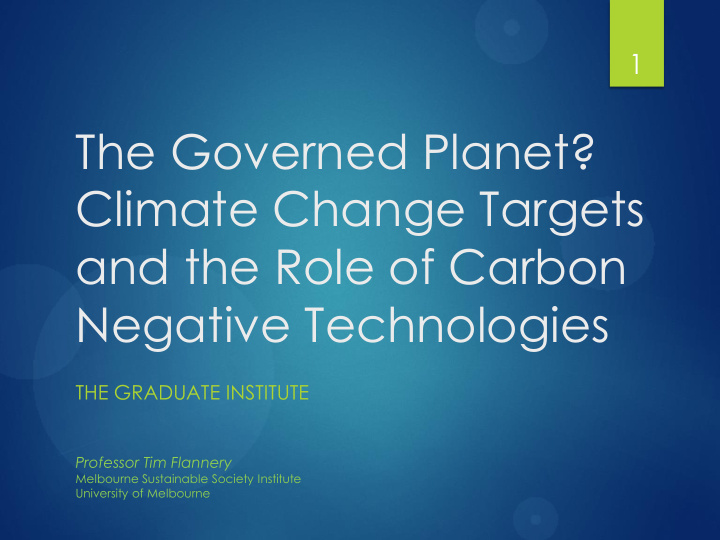



1 The Governed Planet? Climate Change Targets and the Role of Carbon Negative Technologies THE GRADUATE INSTITUTE Professor Tim Flannery Melbourne Sustainable Society Institute University of Melbourne
2 John Tyndall, 1859
The Human Influence 3 Source: IPCC, 2007
The Anthropocene 4 4 Equation
Steve Halley: One Second 5 5
Global Greenhouse Gas 6 Emissions by Sector https://www. ipcc .ch /pdf/assessment- report /ar5/syr/SYR_A R5_FINAL_full.pdf
Who is Responsible? 7
Which ecosystems are 8 8 affected? ‘ Climate change impacts have now been documented across every ecosystem on Earth’
Coral reefs: doomed to 9 9 extinction?
Alpine ecosystems 10 10 In New Guinea, tree-lines rise by 300m per 1C temperature increase.
Are the fish shrinking? 11 11 Source: https://www.abdn.ac.uk/news/5731/
YES 12 12 Up to eight commercial fish species in the North Sea (haddock, whiting, herring, Norway pout, plaice, sole) have shrunk in size…. This is over a 40 year period Coincides with a 1-2 ° C increase in temperature Resulting in a 23% decrease in yield
Wine Anyone? 13 13
14 14 Global food security?
The Paris Agreement 15 15
The Global Carbon Budget 16 Source: Climate Council Global Carbon Budget Report
Biosphere Feedbacks 17 Biosphere climate-carbon cycle feedbacks that could be activated by a ~ 2 C increase in global average temperature. Biosphere Additional Correspondin References/notes climate-carbon cycle feedback carbon g global (see SI for details) process emitted by temperature 2100 (GtC) 1 increase ( C) 2 Relative weakening of land and 0.25 (0.13- Rescaling of results from RCP4.5 “compatible 125 (65-185) ocean C sinks 0.37) emissions” scenario (Ciais et al. 2013). Permafrost thawing, CO 2 and CH 4 0.09 (0.04- Estimates based on Schaefer et al. (2014), Schneider release 45 (20-80) 0.16) von Deimling et al. (2015), Koven et al. (2015). Amazon forest dieback 0.05 (0.03- Based on extrapolation of observed changes and 25 (15-55) 0.11) model projections of dieback (Jones et al. 2009). 0.06 (0.02- Based on extrapolation of observed changes and Boreal forest dieback 30 (10-40) 0.10) model projections of dieback. Increased bacterial respiration in the Rescaling of RCP8.5 results (Segsneider and Bendtsen 10 0.02 ocean 2013, Bendtsen et al., 2015) 0.47 (0.24- Total 235 (120-380) 0.76) 1 Rounded to the nearest 5 GtC Source: Rockström et al., 2 To convert the climate-carbon cycle feedbacks from amounts of carbon emitted to an equivalent 2017, Biosphere climate- temperature rise, we assume a 2 C temperature rise per 1000 GtC added to the atmosphere. carbon cycle feedbacks and the 2 C Paris guardrail
CO 2 is Not The Only 18 Greenhouse Gas Methane and nitrous oxide are not included in the carbon budget because their warming impact is offset by particulate pollution Both China and India are clamping down on particulate pollution Carbon Dioxide ~81%, Methane ~11%, Nitrous Oxide ~6% (https://www.epa.gov/ghgemissions/overview-greenhouse-gases)
O UT OF C ARBON B UDGET 19 “ “Our central estimate gives a total loss of 235GtC equivalent…[This] would consume the entire remaining carbon budget of 225GtC and generate a slight deficit, thus requiring ” negative emissions technologies to respect the 2C Paris guardrail.” Biosphere climate-carbon cycle feedbacks and the 2 C Paris guardrail Johan Rockström 1 , Will Steffen 1,2 , Katherine Richardson 3 , Timothy M. Lenton 4 Submitted Nature
The Virgin Earth Challenge 20
Biological and Chemical 21 Pathways to remove CO 2
Biological and Chemical 22 Pathways to remove CO 2 Carbon Negative Concrete
North America 23
24 24
Kelp Farm 25 25
Mid Pacific Ocean 26 26
Only mid-ocean kelp 27 farming offers storage If 9% of the ocean could be covered in seaweed farms, the farmed seaweed could produce 12 gigatonnes per year of biodigested methane for use as natural gas, while storing 19 gigatonnes of CO 2 . A further 34 gigatonnes per year of CO 2 could be captured if the methane is burned to generate electricity. This would produce sufficient biomethane to replace all of today’s needs in fossil fuel energy, while removing 53 billion tonnes of CO 2 per year from the atmosphere ...This amount of biomass could also increase sustainable fish production to potentially provide 200 kilograms per year, per person, for 10 billion people. Additional benefits are reduction in ocean acidification and increased ocean primary productivity and biodiversity. N’Yeurt , A. et al ., (2012). ‘Negative Carbon via Ocean Afforestation’, Process Safety and Environmental Protection 90, 467 – 74, 2012.
The Deep Sea 28 28
Wind Turbines in the 29 Antarctic
Carbon negative concrete 30 30
Silicate Rocks 31 31
James Hanson et al. see a 32 solution Enhanced weathering could lower atmospheric CO 2 by 30 – 300 ppm by 2100, depending mainly on silicate rock application rate (1 kg or 5 kg m −2 yr −1 ) and composition. At the higher application rate, end-of-century ocean acidification is reversed under RCP4.5 and reduced by about two-thirds under RCP8.5. Additionally, surface ocean aragonite saturation state, a key control on coral calcification rates, is maintained above 3.5 throughout the low latitudes, thereby helping maintain the viability of tropical coral reef ecosystems Layla et al (2016). Enhanced Weathering strategies for stabilising climtate … Nature Climate Change 6:204-6
Direct Air Capture CO 2 33 Source: http://carbonengineering.com/air-capture/
Bioplastics (Plastics from 34 CO 2 ) Source: http://bioplasticolor.blogspot.com.au/201 1/03/polymers-from-carbon-dioxide.html Source: http://www.climate- kic.org/case-studies/plastics-project- potential-co2-reduction-of-2-9m-tons- in-europe/
Sahara CST Licht 35 Technologies: CO 2 and Nanofibres Source: One-Pot Synthesis of Carbon Nanofibers from CO2 Jiawen Ren, Fang-Fang Li, Jason Lau, Luis González-Urbina, and Stuart Licht, Nano Letters 2015 15 (9), 6142-6148
Artificial photosynthesis? 36 Optimised in vitro photosynthetic pathway using 17 enzymes (3 engineered) 5 times more efficient than existing pathways
London 1917 37 37
38
Image Geneva 1950 39 39
Jet Aircraft 1950 40 40
Electrification of the Home 41 41 1950
Nuclear Blast 1950 42 42
What will 2050 be like? 43 43 We are all connected…
Recommend
More recommend